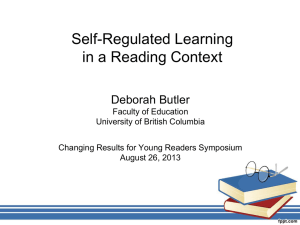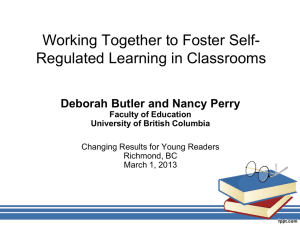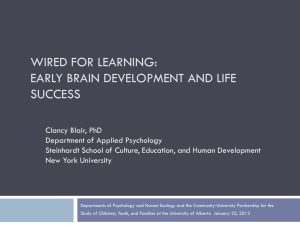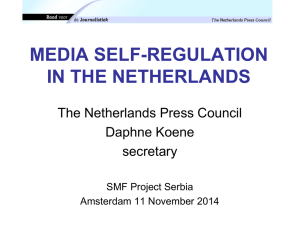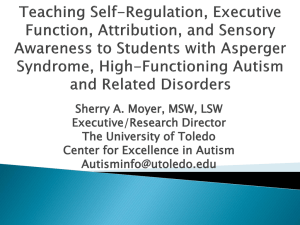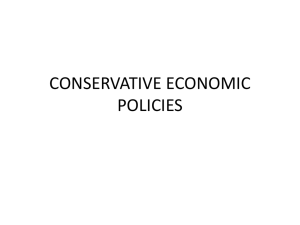Self-Regulation in Reading
advertisement
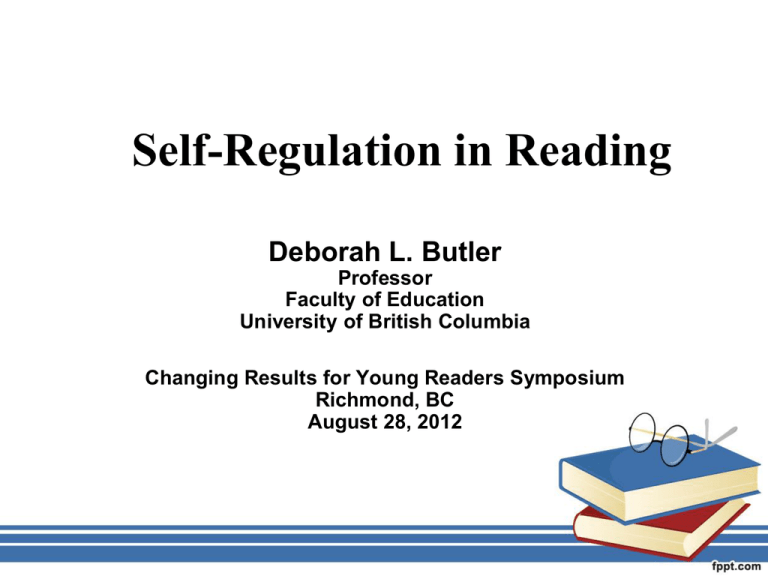
Self-Regulation in Reading Deborah L. Butler Professor Faculty of Education University of British Columbia Changing Results for Young Readers Symposium Richmond, BC August 28, 2012 Questions • What is “self-regulation”? • How can teachers support self-regulation? • How can practices supportive of self-regulation also support diverse learners? What is “Self-Regulation”? • Researchers/educators are taking up discussions of selfregulation from various perspectives • Self-regulation from a developmental perspective: “the ability to respond effectively to various stressors and return to a state of equilibrium – as central to the ability to learn” (from learn, the magazine of BC Education, summer/fall issue, 2012) • Supporting students to be calm and focused (poised to learn) is an important consideration in educational settings Self-Regulation from an Educational Perspective • Others have been using the term “self-regulation,” since the 1970’s, from an educational perspective, to describe active, strategic learning in classrooms • SRL Canada: Canadian Consortium for Self-Regulated Learning (see http://srlcanada.ca/), includes researchers working here in BC, with educators across multiple districts: – – – – Nancy Perry, Deb Butler (UBC-Vancouver) Allyson Hadwin (University of Victoria) Leyton Schnellert (UBC-Okanagan) Phil Winne (SFU) Examples of SRL Projects in BC Qualities of Elementary Classrooms that Support SRL Supporting PreService Teachers to Develop SRLSupportive Practices Developing SRL-Supportive Practices in Intermediate and Secondary Classrooms Teachers in Schools Working Together to Develop SRLSupportive Practices Understanding and Supporting SRL by PostSecondary Learners Self-Regulation as Strategic Engagement • Self-regulation is strategic, goal-directed activity – I have a goal; I do something; Does it work?; I try again. • Self-regulation involves metacognition, emotion, motivation, and strategic action • All individuals self-regulate by managing their participation in activities (from very young learners to adults) • Self-regulation is implicated in a wide range of activities: – Sport & physical activity – Teaching – Academic work in schools • Individuals can take, and feel in control, over their participation in activities by deliberately and reflectively “self-regulating” performance What can Self-Regulation Look Like in a Primary Classroom? Imagine a grade 2/3 classroom in which students have been asked to complete a research project on an animal of their choice. They are asked to do research on their animal by selecting and reading resources, and to write, edit, and “publish” expository text (using the computer; working together) What would self-regulated learning look like for these students? Adapted from Perry & Drummond, 2002 A Model of Self-Regulation as Situated in Context Activity in Context Interpreting Demands & Setting Goals History, Strengths, Challenges, Knowledge, Beliefs, Interests, Agency Adjusting Monitoring Against Criteria Cycles of SelfRegulated Activity Planning Enacting Strategies Question 1 Revisited: What is “Self-Regulation”? • Imagine your goal as supporting reading by young learners (with a focus on making meaning of text(s) and working with ideas) • Can you define one or two ways in which self-regulation is implicated in reading (how would you explain it to colleagues)? • Can you start to imagine how you could support students’ self-regulation in your context? A Cautionary Tale: What Derails Self-Regulation? % of students Areas of Difficulty % of students Interpreting Tasks 76% • Describing task demands • Interpreting assignments 59% 27% Strategy Use 76% • Strategy description • Aware of problems, but not solutions • Implementing strategies 71% 39% 8% Monitoring 49% • Problems defining monitoring criteria • Little evidence of monitoring 48% 10% Based on 100 case studies of postsecondary learners (Butler, 2003) Interpreting Task Demands Expectations on Lily (Grade 8)? To read and learn from a textbook chapter in Science. Lily’s challenge? She feels lost … She’s just not used to this kind of reading. She decides to just search for bold words and memorize their definitions, because this strategy worked well last time she had to answer questions at the end of a chapter. Percentage of Students who Responded Often/Always Lower Mainland School District 2005-06 Learning Through Reading Pretest Grade 8 All Classes (n=611) 100 87 80 82 77 74 80 80 60 51 40 40 44 36 20 0 Read the textsFind important Understand Find Find the main Get a general Understand See how Apply what I details or facts the subject information ideas or idea about the the information read to matter that interests themes subject information I about the different me most read subject goes situations or together problems Interpretation of the Activity: I am being asked to... Memorize information Where does Self-Regulation Break Down? Knowledge of and Control over Strategies For Studying “I read it over once and hope to retain it” For Reading “[I] just reread and reread and reread” “I just read and ... hope I get it” For Learning Math “If I don’t understand something I’ll keep going over it till I do” “[I] read, use rules, find a reasonable answer, cheat” “If I am using them [strategies], I’m not aware of it” For Writing “I write my thoughts as they flow through my mind, in sentences.” “I write down my point and at the end I have a mess.” Butler, 1995 Case Study Example: Jennifer Perceptions of writing ability “unorganized, choppy would be the best way to describe it” Ineffective strategies “I write down my point and in the end I have a mess”. Frustration/giving up “I had to write a researched 500 word ... essay [for a scholarship application]. I couldn’t organize it at all. I couldn’t get any organization flow going. I kept jumping from point to point. So I got frustrated with it and didn’t apply.” Butler, 1995 Jennifer’s Challenges? Example of Jen’s problem taking ownership of a strategy she had been taught for writing papers Outline Introduction A. point 1 B. point 2 II. First topic A. supporting details B. supporting details III. Second topic A. supporting details B. supporting details IV. Conclusion Had be taught “outlining” but didn’t like or understand it Developed a strategy of making “plans” I. Butler, 1995 Outcomes for Jennifer Task performance improved Developed personalized strategies (her “plans”) Transfer of strategic performance I’m so concentrating on flow, I can pick up on other people’s flow now. So like, you know, the teacher’s going on, I no longer write down like, scribbling madly about every single point he makes, but I can almost summarize ... my note-taking is better now. Perceptions of writing ability And then just the marks are a lot different. That, I feel like, you know, like, when you’re walking around the class and we’re getting our essays back, my marks are average or above average. So I feel better about it. Like, I don’t feel like I’m such a dunce. Where does Self-Regulation Break Down? Self-Confidence & Motivation Students may have experienced challenges that lead to: a lack of confidence little sense of control over outcomes (i.e., low self-efficacy) frustration, boredom, anxiety They may: try but be “actively inefficient” give up rebel Key Implications? If students are to take “control” over learning, they need to learn how to: • Actively interpret and articulate expectations • Actively and reflectively self-direct learning with goals/criteria in mind (plan, choose strategies, self-monitor) We can’t “tell” students to feel successful. Key is that they self-assess and experience how their effort/strategies achieve valued goals Challenges to Students’ SelfRegulation • Have you seen these kinds of challenges for some of the students in your context? • Can you start to imagine how you could support students’ self-regulation in your context? The Early Years: Laying the Seeds for Lifelong Self-Regulation Teachers in the early years have great potential to lay the groundwork for lifelong self-regulation by: Supporting learners to: – – – – construct productive conceptions about academic work understand themselves as learners in relation to task demands take responsibility for and control over learning feel in control over learning Creating environments and enacting practices supportive of students’ development of metacognition, motivation, and strategic action Teachers Working Together to Support Self-Regulated Learning Teachers as contextualized decisionmakers Who draw on knowledge, tools, and resources to meet students’ needs in classroom settings Who can work alone or collectively to foster positive outcomes for students Teachers’ Self- or Co-Regulated Practice (Adapted from Butler & Schnellert, 2012) Activity in Context Interpreting Demands & Setting Goals Resources History, Strengths, Challenges, Knowledge, Beliefs, Interests, Agency Adjusting Monitoring Against Criteria Teachers’ selfand co-regulated practice Planning Students’ self-regulated activity Enacting Strategies Intermediate Teachers Working to CoConstruct Practices (Spring 2002) Large Group (Whole Class) Instruction • • • • • • • • • • • • Tracing novel characters’ journey on a map of BC, the Yukon, and Alaska Writing a letter to convince someone not to cancel a favourite TV show Writing a summary of a story Writing poems of different types Judging the quality of a valedictory speech they had written Proofreading stories they had written Learning to multiply and divide fractions and mixed numerals Interpreting math problems to see what they are really asking Learning about geometry concepts: different kinds of triangles Science project: Building a car that moves using concepts about simple machines Social studies lesson: reading and pulling main ideas out of a text Learning to fill out deposit slips (Business Education) Small Group Instruction • • • • • • Reading information sheet on Egyptian Gods in order to answer questions Writing a letter Writing summaries Converting mm to cm to m to km Working with percentages Solving math equations (x + 7 = 14; 24 – g = 19)) Example: Constructing Criteria with Students (Schnellert & Widdess, 2002) Example: Constructing Strategies with Students (Schnellert & Widdess, 2002) Secondary Teachers Working to Promote “Learning through Reading” Teachers who co-constructed and interpreted formative assessment data and collaborated to support self-regulated LTR in subject-area classrooms: observed improvements in student learning associated with goals chosen and types of practices enacted were inspired to engage in professional learning when they observed gaps between student thinking/performance & goals better identified student needs & set targeted goals drew on a variety of resources to identify potential changes constructed and situated practices designed to achieve goals shared insights and practices with one another persevered in the face of obstacles (Butler, Schnellert, & Cartier, 2008) Links to Student Learning? Student outcomes could be linked to teachers’ goals: • A focus on inferencing, reasoned judgments, and main ideas was associated with gains in SRL and reading performance • A focus on details and text features was associated with increases in stress/worry, but not with positive learning outcomes Student gains were greatest when classroom practices: • Sustained attention to goals • Integrated learning goals into the curriculum • Attended explicitly to reading, thinking, learning processes • Fostered student independence (Butler, Schnellert, & Cartier, 2008) Classroom Practices that Support SRL (see Perry & Drummond, 2002) • Designing Complex, Meaningful Tasks • Encouraging Autonomy – Choice – Control over challenge – Student self-evaluation • Supporting Success – Teacher Support – Peer Support • Non-Threatening Evaluation Practices Research About Animals • Grade 2/3 • Science • Linked to reading and writing • Complex – – – – – Goals Meaning Time Processes Products (Perry & Drummond, 2003) Self-Regulation and Inclusion SRL-supportive practices have potential to support inclusion of diverse learners by: •Creating contexts that accommodate diverse learning needs •Drawing students into the process of “individualizing” curriculum •Empowering learners to work more independently (so teachers can target support more effectively) Teachers can also work together in communities of learning to support students’ needs (Schnellert, 2011) Classroom Practices that Support Self-Regulation • Are there principles in this that “make sense” to you, as useful for supporting students’ independent, “strategic” engagement? • Can you think of one small change that you might make in your context, as a start, that might foster some aspect of self-regulation in reading? • What questions do you have about how to support SRL? Resources for Teachers Interesting in Working to Support Self-Regulation Your professional networks/learning communities within and across districts SRL Canada: A network of researchers/educators across institutions Initiatives being constructed also by/across BC universities • Pre-service (e.g., UBC cohort) • On-going professional learning Selected References Brownlie, F., Feniak, C., & Schnellert, L. (2006). Student Diversity (2nd ed.). Markham, ON: Pembroke Publishers. Butler, D. L. (2002). Individualizing instruction in self-regulated learning. Theory into Practice, 41, 81-92. Butler, D. L. (1995). Promoting strategic learning by postsecondary students with learning disabilities. Journal of Learning Disabilities, 28, 170-190. Butler, D. L. (1994). From learning strategies to strategic learning: Promoting self-regulation by postsecondary students with learning disabilities. Canadian Journal of Special Education, 4, 69-101. Butler, D. L., Beckingham, B., & Novak Lauscher, H. J. (2005). Promoting strategic learning by eighth-grade students struggling in mathematics: A report of three case studies. Learning Disabilities Research and Practice, 20, 156-174. Butler, D. L., & Cartier, S. (2004). Promoting students’ active and productive interpretation of academic work: A Key to successful teaching and learning. Teachers College Record, 106, 1729-1758. Butler, D. L., Cartier, S.C., Schnellert, L., Gagnon, F., & Giammarino, M. (2011). Secondary students’ selfregulated engagement in reading: Researching self-regulation as situated in context. Psychological Test and Assessment Modeling, 11(1), 73-105. Butler, D. L., Elaschuk, C. L., & Poole, S. (2000). Promoting strategic writing by postsecondary students with learning disabilities: A report of three case studies. Learning Disability Quarterly, 23, 196-213. Butler, D. L., Novak Lauscher, H. J., Jarvis-Selinger, S., & Beckingham, B. (2004). Collaboration and selfregulation in teachers’ professional development. Teaching and Teacher Education, 20, 435-455. Butler, D. L., & Schnellert, L. (2012). Collaborative inquiry in teacher professional development. Teaching and Teacher Education. (on-line now; to appear in the next issue). Butler, D. L., & Schnellert, L. (2008). Bridging the research-to-practice divide: Improving outcomes for students. Education Canada, 48(5), 36-40. Selected References (cont’d) Butler, D. L., Schnellert, L. & Cartier, S. C. (2012, May). Supporting secondary students’ self-regulated learning through reading in subject-area classrooms. Research Spotlight Session, Canadian Society for the Study of Education. Available at: http://srlcanada.ca/wp-content/uploads/2012/06/Butler-Knowledgesnapshot-CAEP-FINAL.pdf Butler, D. L., Schnellert, L., & Cartier, S. C. (2008, March). Educational change and layers of self-regulation: Teachers working strategically to improve practice so as to foster student self-regulation. Presented at the 2008 meetings of the American Educational Research Association. New York, NY. Butler, D. L., Schnellert, L., & Cartier, S. C. (2008, May). Understanding and supporting adolescents’ learning from text(s) in subject area classrooms. Presented at the 2008 annual meetings of the International Reading Association. Atlanta, GA. Cartier, S. C., & Butler, D. L. (2012, May). Teachers working together to foster self-regulated learning. Research Spotlight Session, Canadian Society for the Study of Education. Available at: http://srlcanada.ca/wp-content/uploads/2012/06/Cartier-Knowledge-snapshot-CAEP2.pdf Cartier, S. C., Butler, D. L., & Bouchard, N. (2010). Teachers working together to foster self-regulated learning through reading by students in an elementary school located in a disadvantaged area. Psychological Test and Assessment Modeling, 52(4), 382-418. Perry, N. E. (2012, May). Classroom contexts for self-regulated learning. Research Spotlight Session, Canadian Society for the Study of Education. Available at: http://srlcanada.ca/wpcontent/uploads/2012/06/Perry-Knowledge-snapshot-CAEP-FINAL.pdf Perry, N. E. (2011). Supporting self-regulation in the early school years. Presentation to the Lower Mainland Early Literacy Coordinators. Perry, N. E. (2004). Using self-regulated learning to accommodate differences amongst students in classrooms. Exceptionality Education Canada, 14(2&3), 65-87. Selected References (cont’d) Perry, N. E., & Drummond, L. (2002). Helping young students become self-regulated researchers and writers. The Reading Teacher, 56(3), 298-310. Perry, N. E., Nordby, C. J., & VandeKamp, K. O. (2003). Promoting self-regulated reading and writing at home and school. The Elementary School Journal, 103(4), 317-338. Schnellert, L. (2011). Collaborative inquiry: Teacher professional development as situated, responsive coconstruction of practice and learning. (Doctoral dissertation). Retrieved from https://circle.ubc.ca/handle/2429/38245. Schnellert, L., Butler, D. L., & Higginson, S. (2008). Co-constructors of data, co-constructors of meaning: Teacher professional development in an age of accountability. Teaching and Teacher Education, 24(3), 725-750. Winne, P. H. & Perry, N. E. (2000). Measuring self-regulated learning. In P. Pintrich, M. Boekaerts, & M. Zeidner (Eds.), Handbook of self-regulation (pp. 531-566). Orlando, FL: Academic Press. Zimmerman, B. J. (1990). Self-regulated learning and academic achievement: An overview. Educational Psychologist, 25, 3-17. Zimmerman, B. J. (2008). Investigating self-regulation and motivation: Historical background, methodological developments, and future prospects. American Educational Research Journal, 45, 166-183.
